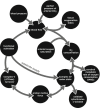Simulation of Preterm Neonatal Brain Metabolism During Functional Neuronal Activation Using a Computational Model
- PMID: 26782202
- PMCID: PMC6116567
- DOI: 10.1007/978-1-4939-3023-4_14
Simulation of Preterm Neonatal Brain Metabolism During Functional Neuronal Activation Using a Computational Model
Erratum in
-
Erratum.Adv Exp Med Biol. 2016;876:E1-E2. doi: 10.1007/978-1-4939-3023-4_66. Adv Exp Med Biol. 2016. PMID: 27785776 Free PMC article. No abstract available.
Abstract
We present a computational model of metabolism in the preterm neonatal brain. The model has the capacity to mimic haemodynamic and metabolic changes during functional activation and simulate functional near-infrared spectroscopy (fNIRS) data. As an initial test of the model's efficacy, we simulate data obtained from published studies investigating functional activity in preterm neonates. In addition we simulated recently collected data from preterm neonates during visual activation. The model is well able to predict the haemodynamic and metabolic changes from these observations. In particular, we found that changes in cerebral blood flow and blood pressure may account for the observed variability of the magnitude and sign of stimulus-evoked haemodynamic changes reported in preterm infants.
Keywords: Autoregulation; Haemodynamics; Mathematical model; Stimulus – evoked functional response; fNIRS.
Figures







References
-
- Springett R, Newman J, Cope M, et al. Oxygen dependency and precision of cytochrome oxidase signal from full spectral NIRS of the piglet brain. Am J Physiol Heart Circ Physiol. 2000;279:H2202–H2209. - PubMed
Publication types
MeSH terms
Substances
Grants and funding
LinkOut - more resources
Full Text Sources
Other Literature Sources
Medical
Research Materials

